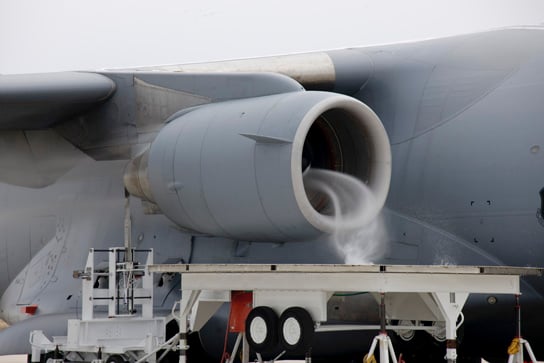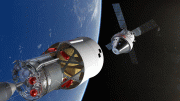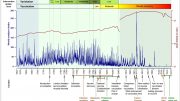
Water forms an interesting cyclonic twist as it is intentionally sucked into the test engine of a U.S. Air Force C-17 transport aircraft during the VIPR project engine health monitoring tests conducted by NASA Dryden. The water was contained on a special platform built by NASA Dryden’s Fabrication Branch for the tests. Credit: NASA / Tony Landis
While foreign objects continue to present dangers for commercial and military airliner passengers, NASA’s Aviation Safety Program is working on new technology that will use improved sensors to detect engine glitches before they become a serious threat.
It might not surprise you to find cereal and crayons beneath your sofa cushions, especially if you are a parent with young children. But what if you found them in a jet engine?
If you’re a NASA engineer, you might declare success in a test of new aircraft engine health monitoring technology designed to provide early warning of engine problems, including the destructive effect of volcanic ash.
NASA’s Aviation Safety Program is developing technology for improved sensors to help spot changes in vibration, speed, temperature and emissions which are symptomatic of engine glitches. These advanced sensors could alert ground crews to problems that can be eliminated with preventive maintenance before becoming serious safety concerns. Ultimately, the sensors could alert pilots to the presence of destructive volcanic ash particles too small for the eyes to see, giving more time for evasive action to prevent engine damage in flight.
Letting a jet engine suck up foreign objects usually is a no-no, but engineers at NASA’s Dryden Flight Research Center will bend the rules in an upcoming experiment with a U.S. Air Force C-17 cargo transport. The cereal and crayons will leave a colorful trail of grains and wax that the researchers can see and study to gauge how well the sensors work.
Dryden engineers ran a similar test using water in December 2011 to lay the groundwork for more complex experiments. They operated the C-17 in normal use and simulated fault conditions after outfitting one of its two Pratt & Whitney F117 turbofan engines – military versions of Pratt & Whitney’s commercial airline PW-2000 turbofan engines – with the advanced sensors.
The second test, in early 2013, will use cereal and crayons to verify that the sensors can detect tiny bits of debris. After that, engineers will conduct a third and final test with very hard, glass-like particles that mimic volcanic ash. Because it is difficult and risky to create problems intentionally on a jet engine in flight, the aircraft will remain on the ground for both tests.
“The point of tossing cereal and crayons into the engine is to trigger some small change for the sensors to detect, without harming the engine,” said Dave Berger, a leader of the Vehicle Integrated Propulsion (VIPR) test series. “Once the sensitivity of the sensors is established, we will end with a real-world scenario by introducing volcanic ash, which really can – and does – tear up an engine.”
The final test with simulated ash will assess how early the health monitoring sensors and their associated software can detect and report a problem. The test will result in the engine’s failure.
“Being able to take an overhauled engine and run it all the way to the end of its life through research experiments is a unique opportunity,” said Berger.
NASA is partnering with the U.S. Air Force and Pratt & Whitney on the VIPR project. Since a volcanic eruption in Iceland disrupted air traffic worldwide for weeks in 2009, there is renewed interest in being able to detect volcanic ash in flight. The Air Force has conducted extensive tests on the effects of volcanic ash ingestion into jet engines, but sensors that can detect the destructive effect of the ash were not available in those tests. They also are not available on current production jet engines.
While instrumentation was being installed on the test engine, NASA Dryden’s Fabrication Branch contributed significant support by building two very unique pieces of ground support equipment. The first was a 24-foot diameter water platform designed to sit below and in front of the research engine during ground testing. This adjustable height platform provided water for the engine to ingest for visualization purposes during tests related to engine diameter as well as its height off the ground.
The other piece of support equipment is an emission sensor rig designed to sit just behind the engine and sweep across the engine’s exhaust path in order to collect exhaust gases for emissions data.
Based at Dryden, VIPR is funded by NASA’s Aeronautics Research Mission Directorate, which manages the Aviation Safety Program.









This is given the easy description in the article and provide the good information which are very useful for the user. Thanks a lot for the option here.